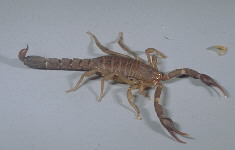Scorpions in Kentucky
ENTFACT-633: Scorpions in Kentucky | Download PDF
by Lee Townsend, Extension Entomologist
University of Kentucky College of Agriculture
 Southern Devil Scorpion
Southern Devil Scorpion
Scorpions bring to mind images of deadly, aggressive creatures that live in the desert regions of the world. However, members of this interesting group can be found in a wide range of habitats. The southern devil scorpion, Vejovis carolinianus, occurs in several southeastern states, including Kentucky. Specimens have been sent in from Adair, Barren, Bullitt, Casey, Estill, Fayette, Hardin, Madison, Marion, Metcalfe, Monroe, Pulaski, and Wayne counties.
Scorpions are very distinctive arthropods. Their large pinchers are used for climbing, holding prey, defense, or courtship and mating. The stinger, located at the end of the long narrow tail, is used for defense or to kill prey.
Scorpions feed on a wide range of small animals including crickets, spiders, caterpillars, and centipedes. They have very poor vision so they often lie in wait for prey, grabbing anything that wanders into their area. Development from birth to the adult stage may take more than a year. Mature individuals, up to 2-5/8 inches long, may live for another 2 years.
Southern devil scorpions are usually found around rocky hillsides. Crumbling rock faces, brick walls, crawl spaces, leaf-covered areas, and log piles are favorite habitats. Scorpions are most likely to be seen in or around houses from April through June but can be active until fall. Dense ground cover, such as leaf litter or mulches, tall grass, wood piles, or general clutter provide excellent protection for scorpions and the small creatures that they eat.
Video of Kentucky Scorpion - University of Kentucky Entomology
Stings
Encounters occur when people disturb these "shelters". Scorpions are not aggressive but will raise their pinchers and tail in an attempt to scare away anything that bothers them. They will strike if touched or accidentally grabbed. A venom, produced by a pair of glands located near the end of the tail, is injected by the stinger. The sensation is a sharp pain that usually lasts for 15 to 20 minutes. Reactions can vary depending on age or sensitivity of the individual and the amount venom injected. Persons stung during early March or April by scorpions just emerging from their winter hiding places may have pain that lasts for several hours, plus a general numbness in the area.
Sanitation, Exclusion, Protection, and Control
Scorpions can be accidental invaders in homes and buildings where they may crawl into or under any object that affords some protection. Gaps around doors are a major entry way for these wandering hunters. Prevent entry by sealing and weather stripping around thresholds and plug gaps where utilities (wire and pipes) enter the structure. Then follow up with a major cleanup to eliminate as many of the hiding places as possible that are so important for scorpions and their prey.
Sanitation and exclusion are the most effective, long-term means of reducing scorpion numbers around dwellings. This should be done in the fall or winter, before scorpions become active in early spring.
During the summer, be careful when picking up objects. Don't forget to look at the undersurface. Shoes and clothing should be shaken out and inspected before getting dressed. Legs of cribs or tables can be placed in wide-mouthed jars, scorpions cannot climb clean glass. Scorpions on the body should be brushed off, not swatted.
Sticky boards placed along wall edges and under furniture can capture scorpions and provide a relatively long-term, nontoxic control method. Exclusion is the more permanent means of excluding pests that come from outdoors but thorough pest-proofing is labor-intensive and sometimes is not practical. Pest proofing can be supplemented by an exterior treatment with an insecticide. Consider applying longer-lasting liquid formulations containing synthetic pyrethroids (e.g. Spectracide Triazicide, Ortho Home Defense, and Bayer Advanced Multi-Insect Killer) that are stocked by many hardware/lawn and garden shops. Use a compressed air or hose end sprayer to treat at the base of all exterior doors, garage and crawl space entrances, around foundation vents and utility openings, and up underneath siding. It may also be useful to treat around the outside perimeter of the foundation in a 2 to 6- foot-wide band along the ground, and 2-3 feet up the foundation wall.
Revised: 07/09
CAUTION! Pesticide recommendations in this publication are registered for use in Kentucky, USA ONLY! The use of some products may not be legal in your state or country. Please check with your local county agent or regulatory official before using any pesticide mentioned in this publication.
Of course, ALWAYS READ AND FOLLOW LABEL DIRECTIONS FOR SAFE USE OF ANY PESTICIDE!
Photo: R. Bessin, University of Kentucky Entomology
